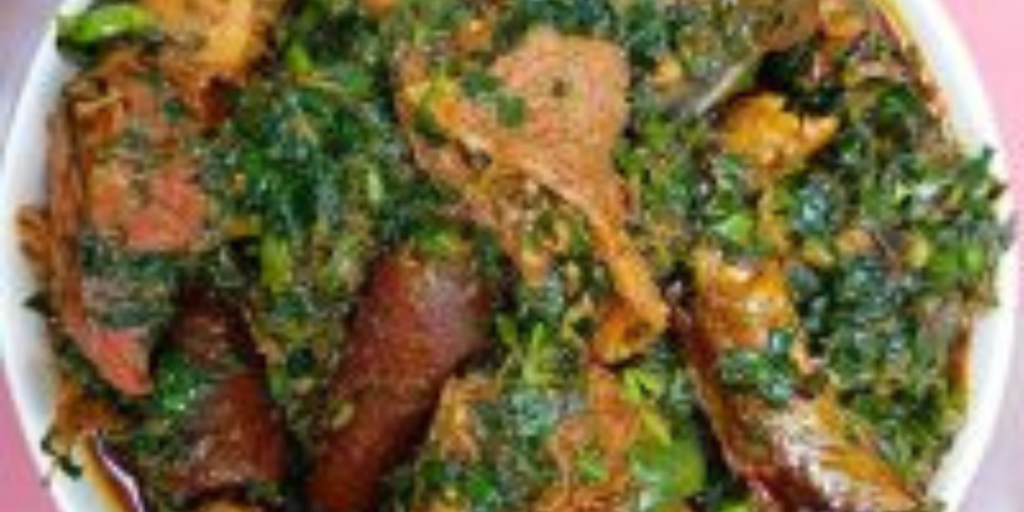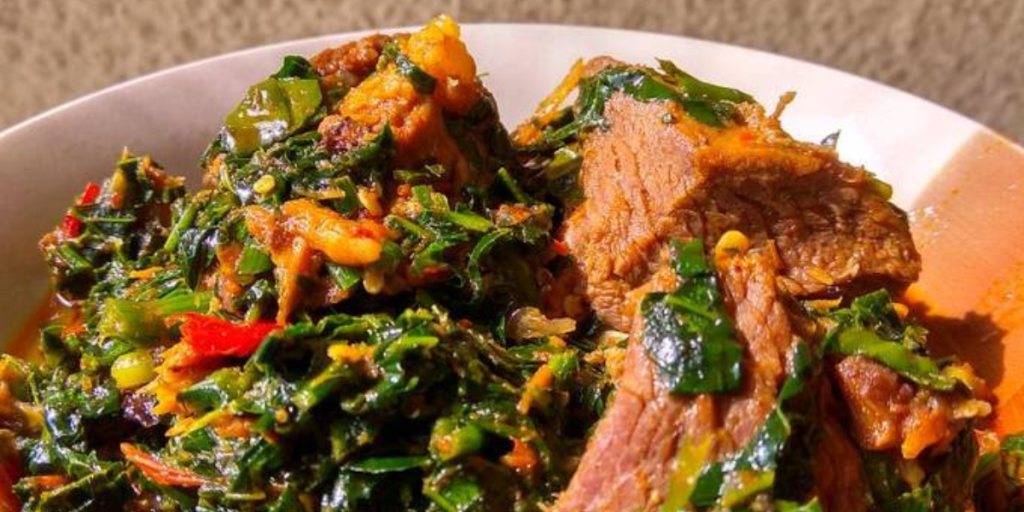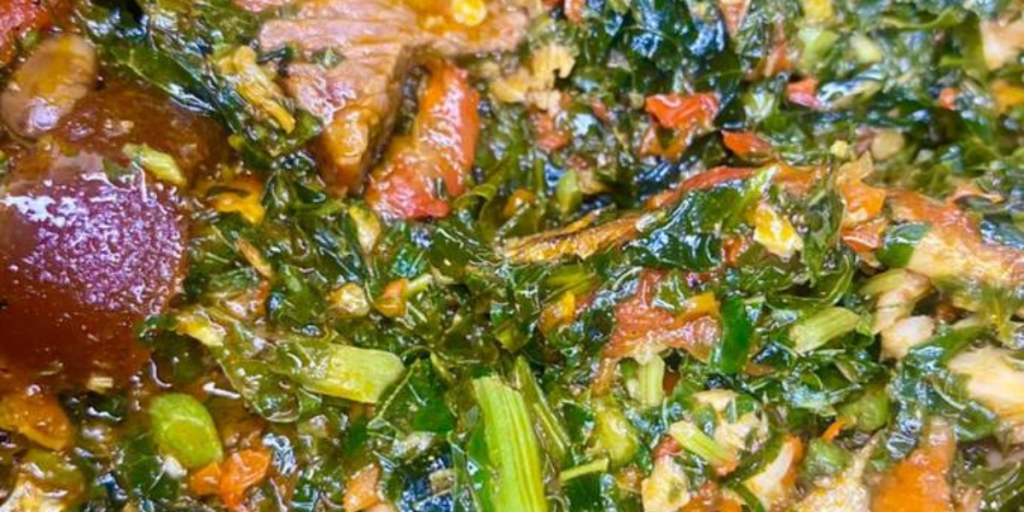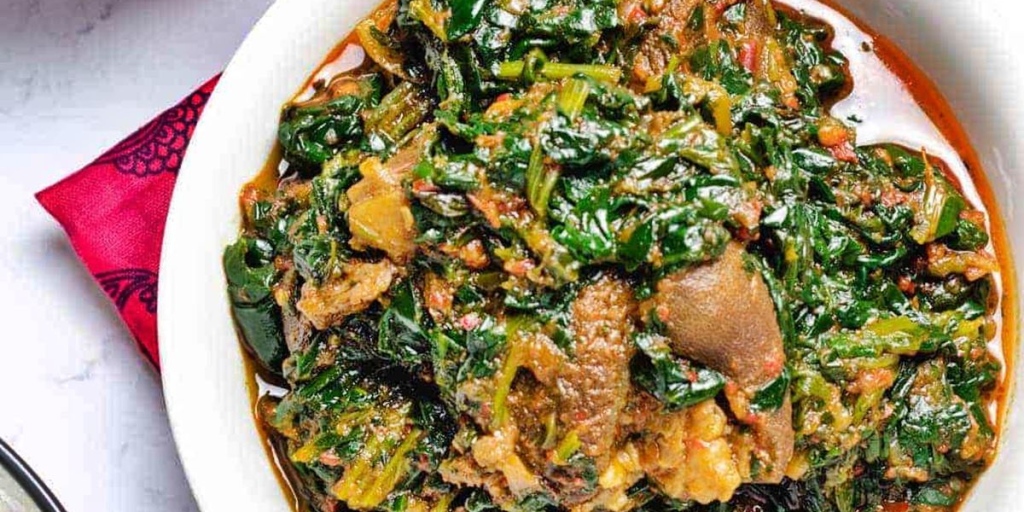Table of Contents
Efo Riro Recipe : Efo Riro is not just a dish; it is an embodiment of the rich culinary traditions of the Yoruba people of Nigeria. While it may seem like just a vegetable soup on the surface, there is a depth of history, culture, and flavor that makes it much more than that. To fully appreciate Efo Riro, one must understand its roots, the importance of its ingredients, and the artistry that goes into making it just right.
The Historical Context of Efo Riro

The origins of Efo Riro can be traced back to the Yoruba ethnic group, who inhabit the southwestern part of Nigeria. The Yoruba people have a long-standing tradition of using leafy vegetables in their cuisine, often combined with palm oil, spices, and a variety of proteins. Historically, these dishes were created not just for sustenance but also as part of ceremonial and celebratory feasts.
Efo Riro became popular for its versatility, as it can be paired with numerous Nigerian staples such as amala, pounded yam, fufu, and rice. Its rich and bold flavors make it a dish of choice for both everyday meals and special occasions. Traditionally, Efo Riro is prepared during festivals, weddings, and other significant gatherings, symbolizing abundance and joy.
How to Make Jollof Rice in 5 Easy Steps: Best of…
Understanding the Role of Key Ingredients
1. Palm Oil: The Essence of Efo Riro
Palm oil is a staple in many West African dishes, known for its distinct flavor and deep red color. In Efo Riro, palm oil serves as the primary cooking oil, infusing the dish with a rich, earthy flavor. It is important to use high-quality, unrefined red palm oil for authenticity. Palm oil also contains a good amount of vitamin E and beta-carotene, which are beneficial for eye health and immune support.
2. Leafy Vegetables: Efo Shoko, Efo Tete, and Substitutes
The traditional leafy greens used in Efo Riro are Efo Shoko (Lagos spinach) and Efo Tete (African spinach), known for their slight bitterness and sturdy texture. These vegetables hold up well to cooking and absorb the flavors of the soup without losing their texture. If these greens are not available, alternatives such as spinach, collard greens, or kale can be used. However, each substitute brings a slightly different texture and flavor to the dish.
3. Assorted Meats: Adding Depth and Variety
One of the reasons Efo Riro is so popular is its inclusion of assorted meats. Traditional Yoruba cuisine often features a combination of beef, goat meat, tripe (shaki), cow skin (ponmo), and other meats to add variety and depth. This assortment ensures that each bite offers a different taste and texture, making the dish more exciting.
4. Iru (Locust Beans): The Secret Ingredient
Iru, also known as locust beans, is a fermented condiment that adds a unique umami flavor to Efo Riro. It has a strong, pungent aroma and taste, which some people describe as an acquired taste. Beyond its flavoring properties, iru is also rich in protein and beneficial probiotics due to the fermentation process. Including iru in the dish is essential for achieving the authentic flavor profile of Efo Riro.
5. Pepper Blend: The Heart of the Soup
The pepper blend used in Efo Riro typically consists of a mix of Scotch bonnet peppers (ata rodo), bell peppers (tatashe), and sometimes tomatoes. This blend forms the base of the soup, providing heat, sweetness, and color. The Scotch bonnet peppers add a fiery kick that is characteristic of many Nigerian dishes, while the bell peppers bring a subtle sweetness.
Thieboudienne: Best Senegalese Jollof Rice and Fish 1
Different Techniques for Preparing Efo Riro

- Using Fresh Versus Dried Fish
- Fresh fish, such as catfish or tilapia, can be used to make Efo Riro, though it requires gentle handling to avoid breaking apart during cooking. On the other hand, dried fish, such as stockfish or smoked catfish, adds a more intense flavor and can withstand the cooking process better.
- Blanching the Leafy Vegetables
- Blanching involves briefly boiling the leafy greens before adding them to the soup. This technique helps retain the vibrant color of the greens and reduces any bitterness, especially if using more bitter leafy greens like Efo Tete.
- Using Low Heat to Fry the Pepper Sauce
- When frying the pepper blend in palm oil, it is important to use low to medium heat. Frying the peppers at a lower temperature for a longer time allows the flavors to develop more fully without burning the peppers.
Efo Riro in Yoruba Culture
Efo Riro holds a special place in Yoruba culture, symbolizing not just nourishment but also celebration and unity. It is often prepared during festive periods such as Christmas, Eid, and family reunions. In many Yoruba households, the preparation of Efo Riro is seen as a communal activity where family members participate, either by chopping vegetables, seasoning the meat, or stirring the pot. The soup brings people together, and its aroma is a sign that something good is cooking in the kitchen.
A Nutritional Breakdown of Efo Riro
Efo Riro is a nutrient-dense dish, with each ingredient contributing to its overall health benefits:
- Vitamins and Minerals: The leafy greens provide vitamins A, C, K, and iron. These vitamins support vision, immune function, and blood clotting, while iron is essential for oxygen transport in the body.
- Protein Content: The combination of assorted meats, fish, and crayfish makes Efo Riro a good source of protein, which is necessary for muscle repair and growth.
- Dietary Fiber: Leafy vegetables are high in fiber, aiding digestion and helping to maintain a healthy weight.
- Heart-Healthy Fats: While palm oil is high in saturated fat, it also contains antioxidants and can be part of a balanced diet when consumed in moderation.
Nigerian Dinner Ideas for Tonight: Best of 2024
Popular Variations Across Different Regions in Nigeria

Lagos Style Efo Riro: A Modern Fusion of Flavors
Lagos, Nigeria’s largest city and economic hub, is a melting pot of cultures, traditions, and cuisines. The cosmopolitan nature of Lagos means that its version of Efo Riro incorporates influences from various ethnic groups while still retaining its Yoruba roots. Here’s a detailed exploration of the characteristics of Lagos-style Efo Riro:
Characteristics of Lagos-Style Efo Riro
- Milder Spice Levels: Given the diversity of people in Lagos, the dish is often prepared with milder spice levels to accommodate different palates. While Efo Riro traditionally includes a lot of Scotch bonnet peppers, Lagos-style versions may use fewer peppers or add a bit of bell pepper to balance the heat.
- Varied Protein Choices: Lagos offers a wide range of proteins due to its vibrant markets. The Efo Riro here often includes not just traditional meats like beef and goat meat, but also fresh fish, seafood, and sometimes even chicken. It’s not uncommon to see Efo Riro made with a combination of fresh fish (such as tilapia) and assorted meats (ponmo, shaki, and beef), making it a hearty meal.
- Inclusion of Ponmo (Cow Skin): Ponmo is a beloved addition in Lagos-style Efo Riro, adding a unique chewy texture to the dish. It is typically cut into small pieces and simmered in the stew to absorb the rich flavors of the pepper sauce.
- Use of Crayfish and Stockfish: Lagos Efo Riro sometimes incorporates crayfish for added umami and stockfish (panla), a dried cod that brings a distinct flavor to the dish. These ingredients are more readily available in Lagos, given the city’s bustling fish markets.
- Palm Oil Usage: In Lagos, the palm oil used in Efo Riro is often unrefined, giving the dish its characteristic reddish hue. Some Lagosians prefer a generous amount of palm oil, while others opt for a lighter touch to reduce the oiliness.
The Role of Efo Riro in Lagos Culture
Lagos-style Efo Riro reflects the fast-paced life of the city. It’s a popular dish for busy families because it can be prepared in large quantities and stored for days. It is also commonly served at “owambe” parties (large Nigerian celebrations) due to its rich flavor, which complements various side dishes like rice, yam, or fufu. In these settings, Efo Riro is a symbol of abundance, as it is often prepared with an array of meats and fish.
Unique Ingredients and Techniques
- Blanching the Vegetables: In Lagos-style cooking, leafy vegetables like spinach or Lagos spinach (Efo Shoko) may be blanched before being added to the stew to maintain a vibrant green color.
- Low-Heat Frying: The pepper mixture is often fried over low heat for an extended period, allowing the flavors to meld together gradually. This technique prevents burning while ensuring the palm oil fully absorbs the flavors of the peppers and spices.
- Adding Fresh Fish at the End: If fresh fish is used, it is typically added towards the end of the cooking process to avoid breaking apart. The fish is simmered gently to soak up the flavors of the stew.
Ogun State Style Efo Riro: An Ode to Tradition

Ogun State, located in southwestern Nigeria, is known for its deep-rooted Yoruba traditions and culinary heritage. The Ogun-style Efo Riro maintains a closer link to traditional Yoruba cooking techniques and ingredients. This variant often emphasizes bold flavors and the use of locally available ingredients like dried fish and bitter leaves.
Characteristics of Ogun State Efo Riro
- Spicier Flavor Profile: Ogun-style Efo Riro is typically spicier than the Lagos variant, reflecting the region’s preference for heat. Scotch bonnet peppers (ata rodo) are used generously, giving the dish a fiery kick.
- Bitter Leaf as an Addition: In some parts of Ogun State, a small amount of bitter leaf is added to Efo Riro to introduce a slight bitterness that balances the richness of the palm oil. This addition makes the dish more unique compared to the more commonly used spinach (Efo Tete) or Lagos spinach.
- Dried Fish as a Staple: Dried fish varieties, such as stockfish (panla) and smoked catfish, are popular in Ogun-style Efo Riro. These dried fish bring an intense, smoky flavor to the dish, adding complexity to the taste.
- Generous Use of Iru (Locust Beans): Ogun people are known for using large amounts of locust beans in their cooking. In Efo Riro, iru plays a significant role, infusing the dish with a deep umami flavor. The locust beans are sometimes crushed before adding them to the stew to release their flavors more effectively.
- Palm Oil Quantity: Ogun-style Efo Riro often uses a more generous amount of palm oil, giving the dish a richer, denser consistency. This style is ideal for those who enjoy the full-bodied flavor of palm oil in their dishes.
The Role of Efo Riro in Ogun State Culture
Efo Riro is a dish that is often shared among family members, especially during special occasions such as traditional weddings, naming ceremonies, and annual festivals like the Ogun State Yam Festival. The addition of bitter leaves and assorted meats makes it a hearty dish that symbolizes togetherness and abundance.
Cooking Techniques for Ogun State Style
- Extended Frying of Pepper Sauce: The pepper sauce is fried for a longer period in Ogun-style Efo Riro to deepen the flavor. This process is done on low heat to allow the palm oil to absorb the pepper’s taste without burning.
- Incorporating Bitter Leaf at the End: If bitter leaf is used, it is added towards the end of the cooking process. This technique helps to maintain its slight bitterness without overpowering the dish.
- Rehydrating Dried Fish: Dried fish is soaked in warm water to soften it before being added to the stew. This step ensures the fish absorbs the flavors of the Efo Riro while still retaining its texture.
- Nigerian Dinner Ideas |List of Food for Dinner Best 5
Ondo and Ekiti Style Efo Riro: A Rich Blend of Traditional Tastes

The Ondo and Ekiti regions share similar culinary traditions, as both are located in southwestern Nigeria and are home to the Yoruba people. The Efo Riro variants from these areas are distinguished by the use of indigenous ingredients and techniques that reflect a deep respect for traditional cooking.
Characteristics of Ondo and Ekiti Style Efo Riro
- Emphasis on Iru (Locust Beans): In Ondo and Ekiti styles, more locust beans are used compared to other regions. This gives the dish a robust fermented flavor. Iru is often added generously, sometimes along with other indigenous seasonings to enhance the taste.
- Inclusion of Bush Meat: Bush meat, such as grasscutter or antelope, may be used in place of or alongside traditional meats like beef and goat meat. This adds a gamey flavor that is prized in these regions. The use of bush meat is a nod to the traditional hunting practices of the people.
- Different Types of Vegetables: While Efo Tete (African spinach) is commonly used, other indigenous vegetables such as Ebolo or Ewedu (jute leaves) may be included for a unique texture and flavor.
- Intense Palm Oil Flavor: The palm oil used in Ondo and Ekiti Efo Riro is often deeply infused with the flavor of the locust beans and spices, creating a dish that is rich and aromatic. Sometimes, the palm oil is pre-heated with iru before adding the pepper mixture, allowing the locust beans to release their flavors early on.
- Dried and Smoked Fish: Like Ogun State, the Ondo and Ekiti variants make extensive use of dried and smoked fish. The fish adds a layer of smokiness to the dish, complementing the richness of the palm oil and spices.
Cultural Significance in Ondo and Ekiti Regions
In these regions, Efo Riro is not just food; it is a cultural experience. It is often prepared for traditional festivals such as the Ogun Festival or New Yam Festival. Families come together to cook large pots of Efo Riro, sharing stories and passing down cooking techniques from one generation to the next. The use of indigenous ingredients and local cooking methods connects people to their roots and cultural heritage.
Cooking Techniques for Ondo and Ekiti Style Efo Riro
- Pre-heating Palm Oil with Iru: This method helps to release the aromatic qualities of the iru early in the cooking process, making the dish more flavorful.
- Slow-Cooking the Pepper Mixture: The pepper blend is slow-cooked with the palm oil to achieve a thicker consistency and richer taste. This technique helps the flavors meld together harmoniously.
- Adding Bush Meat and Fish Gradually: In traditional Ondo and Ekiti cooking, the proteins are added in stages, starting with tougher meats like bush meat, followed by softer meats, and finally, dried fish. This ensures that each type of meat is cooked perfectly without overcooking any one ingredient.
- Often includes ponmo and fresh fish, with a focus on mild spice levels to cater to a diverse population.
How to Make a Healthier Version of Efo Riro
For those looking to make Efo Riro with a healthier twist, consider these modifications:
- Use Less Palm Oil: While palm oil is traditional, reducing the amount can lower the calorie content.
- Opt for Leaner Proteins: Instead of fatty meats, use lean cuts of beef or chicken.
- Increase the Vegetable Content: Add more leafy greens to enhance the fiber and nutrient density.
- Use Fish as the Primary Protein: Fish is generally lower in fat and provides healthy omega-3 fatty acids.
The Global Popularity of Efo Riro
As Nigerian cuisine continues to gain global recognition, Efo Riro has found its way onto the menus of African restaurants in cities like London, New York, and Toronto. The dish’s rich flavors and cultural significance make it a popular choice among both Africans and non-Africans who are looking to experience authentic Nigerian food.
Efo Riro Recipe Tips for Beginners
- Start with a Small Batch: If it’s your first time making Efo Riro, start with a smaller quantity to get a feel for the dish.
- Adjust the Pepper Blend to Your Taste: If you’re not used to spicy foods, reduce the amount of Scotch bonnet peppers.
- Get the Right Palm Oil: If you can, source red palm oil from a trusted African store to ensure you get the authentic flavor.
Advanced Techniques to Elevate Your Efo Riro
For seasoned cooks, there are ways to take Efo Riro to the next level:
- Use a Charcoal Grill for the Meat: Grilling the meat over charcoal before adding it to the soup infuses a smoky flavor that adds depth to the dish.
- Incorporate Fresh Herbs: Adding fresh herbs like basil or scent leaf towards the end of cooking can bring a new layer of aroma.
- Experiment with Different Types of Seafood: Including shellfish such as prawns or mussels can add a gourmet touch.
The Role of Efo Riro in Nigerian Food Blogs and YouTube Channels
With the rise of food blogs and cooking channels, Efo Riro has gained significant attention online. Many food bloggers share their personal twists on the traditional recipe, making it accessible to a global audience. YouTube cooking tutorials offer step-by-step visual guides that can be particularly helpful for beginners who want to learn the art of Nigerian cooking.





















